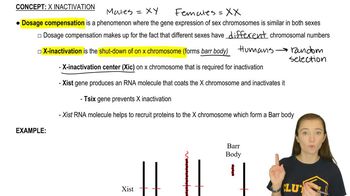Table of contents
- 1. Introduction to Genetics51m
- 2. Mendel's Laws of Inheritance3h 37m
- 3. Extensions to Mendelian Inheritance2h 41m
- 4. Genetic Mapping and Linkage2h 28m
- 5. Genetics of Bacteria and Viruses1h 21m
- 6. Chromosomal Variation1h 48m
- 7. DNA and Chromosome Structure56m
- 8. DNA Replication1h 10m
- 9. Mitosis and Meiosis1h 34m
- 10. Transcription1h 0m
- 11. Translation58m
- 12. Gene Regulation in Prokaryotes1h 19m
- 13. Gene Regulation in Eukaryotes44m
- 14. Genetic Control of Development44m
- 15. Genomes and Genomics1h 50m
- 16. Transposable Elements47m
- 17. Mutation, Repair, and Recombination1h 6m
- 18. Molecular Genetic Tools19m
- 19. Cancer Genetics29m
- 20. Quantitative Genetics1h 26m
- 21. Population Genetics50m
- 22. Evolutionary Genetics29m
19. Cancer Genetics
Overview of Cancer
Problem 15b
Textbook Question
Mammography is an accurate screening technique for the early detection of breast cancer in humans. Because this technique uses X rays diagnostically, it has been highly controversial. Can you explain why? What reasons justify the use of X rays for such a medical screening technique?
 Verified step by step guidance
Verified step by step guidance1
<span>Mammography is a screening tool that uses low-dose X-rays to create images of the breast, which can help detect tumors that cannot be felt. The controversy arises because X-rays are a form of ionizing radiation, which can potentially cause damage to DNA and increase the risk of cancer. However, the dose used in mammography is very low, and the benefits of early detection of breast cancer often outweigh the risks.</span>
<span>The primary justification for using X-rays in mammography is the significant benefit of early detection of breast cancer. Early detection can lead to early treatment, which significantly improves the chances of successful treatment and survival. The risk of radiation-induced cancer from mammography is considered very low compared to the potential life-saving benefits.</span>
<span>Another reason justifying the use of X-rays in mammography is the improvement in technology and techniques over the years, which have reduced the radiation dose while maintaining image quality. This advancement has made mammography a safer option for regular screening.</span>
<span>Furthermore, mammography is a non-invasive procedure, making it a preferable option for regular screening compared to more invasive diagnostic methods. It provides a quick and relatively painless way to screen for breast cancer.</span>
<span>In summary, while there is a risk associated with the use of X-rays, the benefits of early detection and improved survival rates justify its use in mammography. The risk is minimized by using the lowest possible dose of radiation and by ensuring that the procedure is only performed when necessary.</span>
Recommended similar problem, with video answer:
 Verified Solution
Verified SolutionThis video solution was recommended by our tutors as helpful for the problem above
Video duration:
1mPlay a video:
Was this helpful?
Key Concepts
Here are the essential concepts you must grasp in order to answer the question correctly.
Mammography and X-rays
Mammography is a specialized medical imaging technique that uses low-dose X-rays to create detailed images of the breast tissue. This method is crucial for early detection of breast cancer, allowing for timely intervention. However, the use of X-rays raises concerns due to the exposure to ionizing radiation, which can potentially increase the risk of developing cancer over time.
Recommended video:
Guided course

X-Inactivation
Radiation Exposure and Risk
The use of X-rays in mammography involves exposure to ionizing radiation, which can damage DNA and lead to mutations. While the risk of radiation-induced cancer from a single mammogram is low, cumulative exposure from repeated screenings can raise concerns. Understanding the balance between the benefits of early cancer detection and the risks associated with radiation exposure is essential in evaluating mammography's effectiveness.
Recommended video:
Guided course

RNA Interference
Benefits of Early Detection
Early detection of breast cancer through mammography significantly improves treatment outcomes and survival rates. By identifying cancer at an earlier stage, patients can receive less aggressive treatments and have a higher chance of successful recovery. This benefit often justifies the use of X-rays, as the potential risks are outweighed by the advantages of catching cancer early when it is most treatable.
Recommended video:
Guided course

Cell-cell interactions

 9:51m
9:51mWatch next
Master Cancer Characteristics with a bite sized video explanation from Kylia Goodner
Start learningRelated Videos
Related Practice



